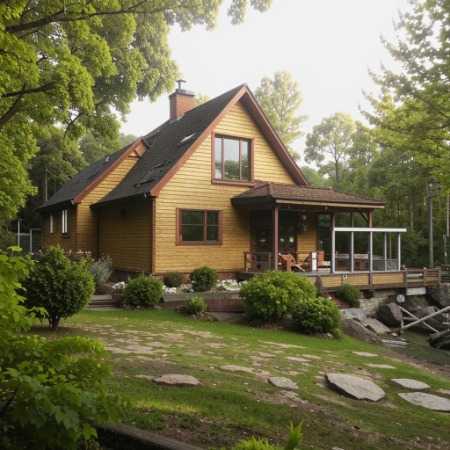Standing seam roofing is one of the most durable and aesthetically pleasing types of roofing systems, widely used in residential and industrial construction. The main feature of this roofing type is the presence of seams — special vertical or inclined joints that ensure the tightness and strength of the metal sheet connections. However, proper fastening of a standing seam roof is a complex technological process on which the durability, reliability, and appearance of the entire roofing system directly depend.
Roof fastening includes not only the mechanical attachment of metal sheets to the substrate but also the correct formation of seam joints, consideration of metal thermal expansion, and ensuring ventilation and waterproofing. Mistakes during fastening often cause leaks, deformations, and premature wear of the roof covering.
This article covers all key aspects of standing seam roof fastening: types of fasteners, installation features, material selection, climate impact, common mistakes, and prevention methods.
Features of Standing Seam Roof Construction
Standing seam roofing consists of metal sheets connected by seams — special folds at the sheet edges. Depending on the seam formation method, there are standing seams and flat seams. Standing seams are vertically oriented, while flat seams are more horizontal.
Seam construction provides excellent waterproofing and allows compensation for metal thermal expansion without cracking. Fastening must consider the material properties — metal expands and contracts, requiring special fasteners and techniques.
An important element is the roof substrate, which can be solid (plywood, OSB) or battens, influencing fastener choice and installation method. Additionally, ventilation elements for the roof space must be considered during fastening.
Types of Fasteners for Standing Seam Roofs
Various fasteners are used for standing seam roofs, each with advantages and limitations.
The most common fasteners are self-tapping screws with sealing washers. They provide reliable attachment to the substrate and high corrosion resistance if the coating is properly selected. Proper quantity and placement are crucial to avoid sheet deformation.
Special clips are also used — metal clamps that secure sheets without piercing the metal. Clips allow thermal movement compensation and offer a cleaner appearance as fasteners are hidden.
In some cases, corrosion-resistant nails are used but require additional sealing. Rivets are also sometimes applied, especially with thin metals.
Fastening Technology: Stages and Features
Fastening begins with substrate preparation. The surface must be flat, dry, and clean. For solid substrates, defects, unevenness, and moisture must be absent to prevent deformation and damage.
Next, a waterproofing layer is installed to protect against moisture and condensation. The layer must be continuous without gaps or folds, especially at joints.
Metal sheets are installed starting with a starter strip to set alignment. Sheets overlap, and seams are formed manually or with special machines.
Sheets are fastened with chosen fasteners: screws into pre-drilled holes or clips on battens. Uniform and tight fastening is key to prevent gaps and deformation.
Corners, roof penetrations, and parapet junctions are finished with additional sealants and gaskets.
Fastener Materials: Selection and Comparative Analysis
Fastener material choice depends on roof metal type, climate, and structure. Common materials are stainless steel, galvanized steel, and aluminum.
Stainless steel offers high corrosion resistance and durability, ideal for harsh climates and coastal areas but more expensive.
Galvanized steel with polymer coating is more economical but requires monitoring to prevent corrosion. Aluminum fasteners are lightweight and corrosion-resistant but less mechanically strong, suitable for light roofs.
| Material | Corrosion Resistance | Mechanical Strength | Cost | Recommended Use |
|---|---|---|---|---|
| Stainless Steel | Very High | High | High | Marine, aggressive environments |
| Galvanized Steel | Medium | High | Medium | General conditions |
| Aluminum | High | Medium | Medium | Lightweight constructions |
Climate Impact on Fastener Selection and Installation
Climate greatly influences fastener choice and installation methods. High humidity, heavy precipitation, and temperature swings require corrosion-resistant and mechanically strong fasteners.
Cold climates necessitate consideration of ice and snow loads, requiring reinforced fasteners and additional fixing elements.
Hot climates require allowance for thermal expansion and UV resistance to prevent coating degradation.
Common Fastening Mistakes and Prevention
Common mistakes include incorrect fastener type and placement. Excess screws cause sheet deformation; too few cause loosening and leaks.
Improper seam formation — insufficient fold tightness or metal damage — compromises waterproofing and strength.
Poor substrate preparation and lack of waterproofing reduce roof durability, leading to corrosion and deformation.
Strict adherence to installation technology, quality materials, and inspection at all stages prevent these issues.
Maintenance of Standing Seam Roof Fastening
Regular maintenance extends roof lifespan. Inspect fasteners for corrosion, loosening, sheet deformation, and seam damage.
Prompt repair or replacement of defective parts is essential.
Cleaning debris, snow, and leaves prevents moisture retention and corrosion. Sealant and gasket conditions near junctions must be monitored.
Conclusion
Standing seam roof fastening is a complex and critical process requiring careful material selection, installation technology, and climate consideration. Proper fastening ensures roof reliability, waterproofing, durability, aesthetics, and safety.
Avoiding common mistakes and considering all factors significantly prolongs roof service life and reduces repair costs. Engaging qualified professionals and certified materials is recommended for best results.

